
Asheville Website Design for Small Business. Secure, Affordable, and Effective!

Important Note for Replicating Our Test Results: The first four of the five pages in this image speed test were conducted using a non-SSL secured environment. Those four pages had caching and compression disabled with the .htaccess file. And they did not have the benefit of a CDN. We wanted the most accurate measurements of initial page loading speed. The fifth test page utilized all of those features.
To replicate the results shown on this page, please visit that non-secured testing site directly at advertisinggarage.com/imgspeedtest
The files hosted here on the secured joeinfo.com site will load faster due to SSL, CDN, compression, and caching optimizations.
When comparing the five pages in our test, the image quality appeared to be the same, even though our large hero image at the top of each page ranged from 745k (unoptimized) to 58.5k (AVIF compression).
Using Chrome's Developer Tools > Networking tab, here's a breakdown of how each of our pages performed:
No optimizations were applied. The image is in its original size and format (JPG), which caused the page to load slowly due to its large file size.
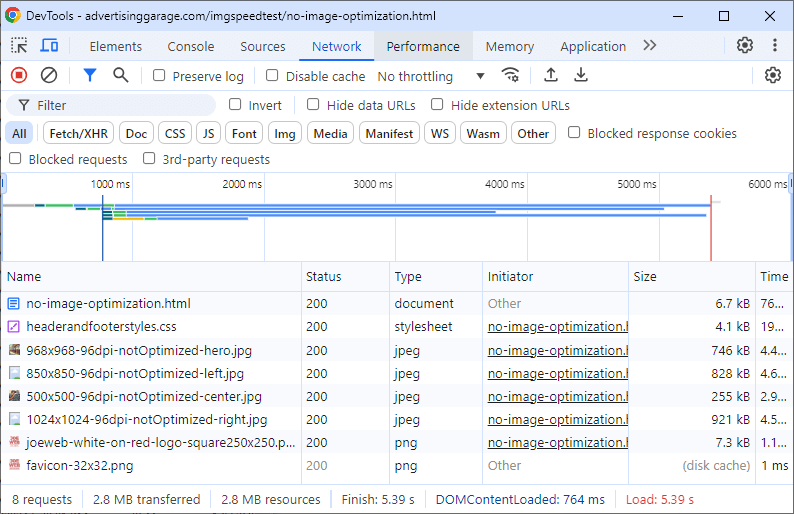
This approach uses media queries to load smaller images for mobile devices, reducing the file size significantly. However, it doesn't support multiple formats, so JPG is still the only option.
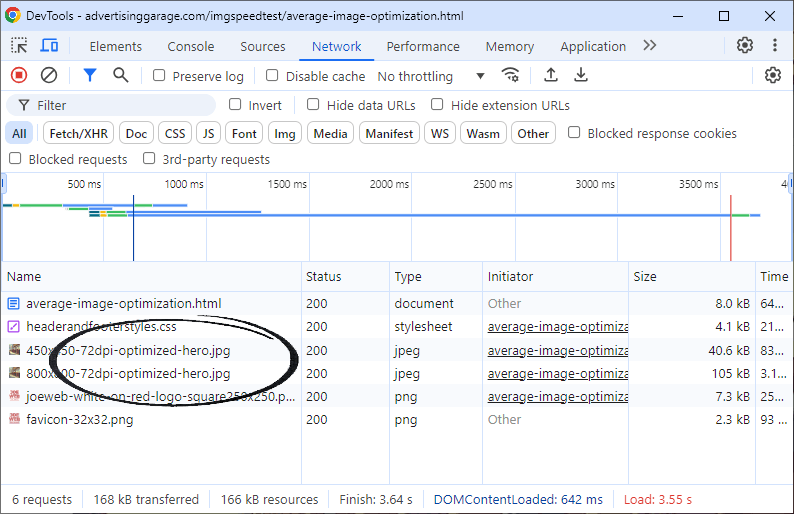
Above: Due to the use of media queries, we have both the large and small hero images (at the top of the page) loading. Unfortunately, the browser needed only one of them. Note also that the three 'Gallery' section images (at the bottom of the page) are not on the initial download list. Adding img loading="lazy" instructed the browser to delay loading those until they come into view.
The img tag with srcset allows for multiple image sizes to be served based on the user's device resolution. This reduces load time without sacrificing quality on high-resolution screens.
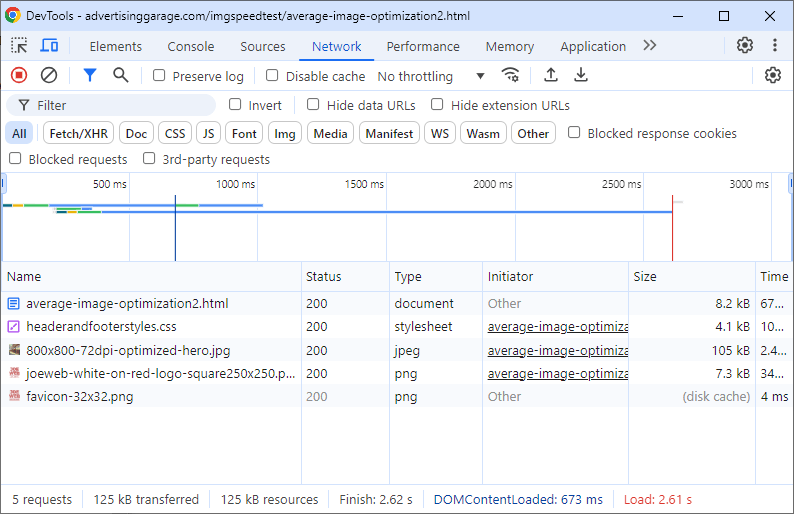
This is a more advanced method, serving different formats (AVIF, JPG, and WebP) and sizes depending on device resolution. It shaves an additional 1 1/4 second off of the JPG-only method without compromising image quality.
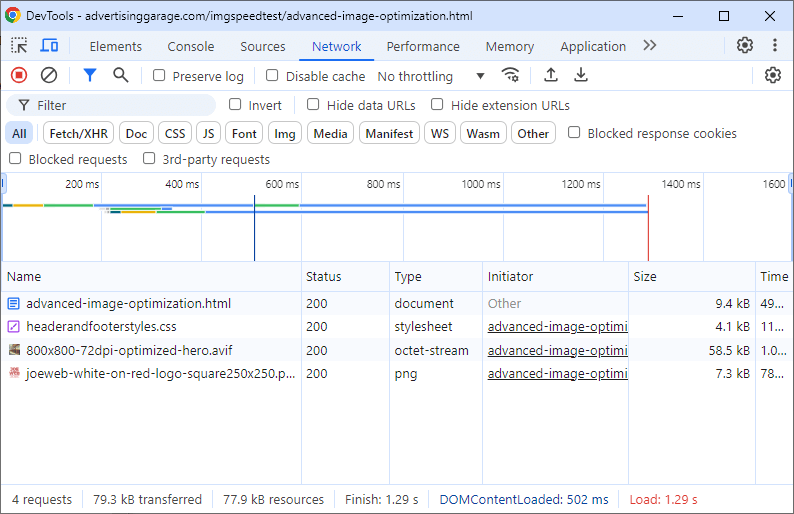
Above: Note that the AVIF format was downloaded for the hero image.
This is the fastest and most advanced method by far. It uses the same configuration as Approach 4 (picture tag with srcset), but the page is now served from Joeinfo.com's secure, CDN-optimized server, rather than from the non-secure, uncompressed AdvertisingGarage.com server, which is hosted on basic GoDaddy infrastructure.
This test highlights the significant advantages of using SSL, Cloudflare CDN, and Brotli compression. For accuracy, we cleared the browser cache prior to testing to measure the true initial load time. (On subsequent visits, with elements loaded from browser cache, the load time improves to a blazing-fast 15-21 milliseconds!)
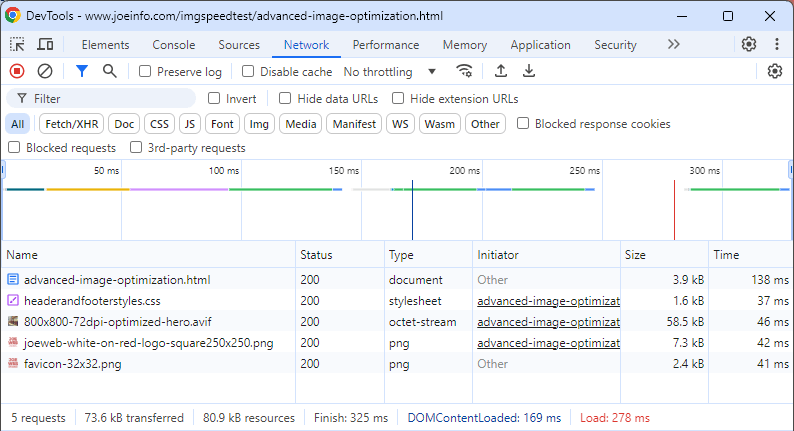
| Approach | Initial Load | File Size | Formats | Responsive |
|---|---|---|---|---|
| 1. No Optimization | 5.39s | 2.8MB | JPG | No |
| 2. Media Queries (JPG) | 3.55s | 168KB | JPG | Yes |
| 3. Img Tag with Srcset (JPG) | 2.61s | 125KB | JPG | Yes |
| 4. Picture Tag w/ SrcSet (AVIF) | 1.29s | 79.3KB | AVIF, JPG, WebP | Yes |
| 5. Approach 4 + SSL, CDN, Compression | 1/4s | 73.6KB | AVIF, JPG, WebP | Yes |
img loading="lazy" and resizing images to their maximum rendered size helped a lot. But loading both the large and small hero images slowed the page.Optimizing your images can have a significant impact on your website's performance. As our test showed, moving from no optimization to advanced techniques (like the picture tag with srcset and AVIF format) can drastically reduce load times, improving user experience, and search engine rankings.
If you'd like to speed up the loading of your images--or your entire site--we can help. Need a new site? We're the best web design agency in Asheville for that, too! Just give us a call at 828-515-9761.
© 2025 Joe Web site design, Asheville, NC
Call: 828-551-9761 • EMail: info@JoeWeb.com